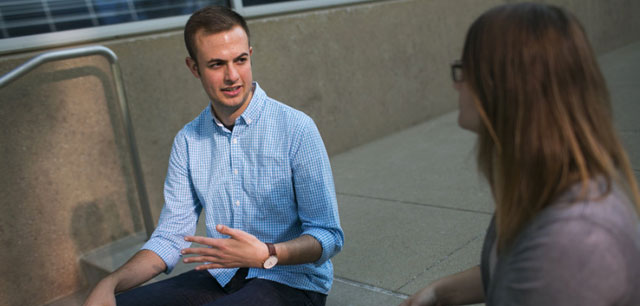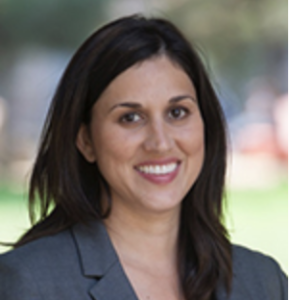
By Andrea Petersenlood, The Wall Street Journal
On a recent Thursday afternoon at Ohio State University, about 30 students sit in a classroom listening to instructor Kipp Pietrantonio lecture. “Imagine you were just handed your physics test, what would happen?” he asks.
“You sweat,” calls out one student.
“Your heart starts racing,” says a young woman.
“You get jittery,” answers another.
It is a meeting of the twice weekly “Beating Anxiety” workshop” and Dr. Pietrantonio is a clinical psychologist who works at the university’s counseling center. The workshop advises students to tackle anxiety by exercising, getting enough sleep and reframing catastrophic thoughts (if my friend doesn’t text me back right away, she hates me) in more logical ways (maybe she’s studying) among other strategies.
It is one part of Ohio State’s effort to cope with the dramatic increase in the number of its 59,000 students on the Columbus campus seeking help for mental-health issues.
Ohio State has seen a 43% jump in the past five years in the number of students being treated at the university’s counseling center. At the University of Central Florida in Orlando, the increase has been about 12% each year over the past decade. At the University of Michigan in Ann Arbor, demand for counseling-center services has increased by 36% in the last seven years.
Nationwide, 17% of college students were diagnosed with or treated for anxiety problems during the past year, and 13.9% were diagnosed with or treated for depression, according to a spring 2016 survey of 95,761 students by the American College Health Association. That is up from 11.6% for anxiety and 10.7% for depression in the spring 2011 survey. Counseling centers say they are also seeing more serious illnesses, including an uptick in the number of students coming to college with long psychiatric histories.
It is unclear why the rates of mental-health problems seem to be increasing among college students. Therapists point to everything from the economy and rising cost of tuition to the impact of social media and a so-called helicopter-parenting style that doesn’t allow adolescents to experience failure. Students are “overwhelmed with stress,” says Micky M. Sharma, director of Ohio State’s Student Life Counseling and Consultation Service. “The coping, the resiliency is not where we want it to be. That’s a bad combination.”
College counseling centers are struggling to respond as more students seek help for anxiety, depression as well as typical college adjustment issues like break-ups and stress over grades. Student Ashley Miley (via Skype) joins Lunch Break’s Tanya Rivero discuss how colleges are adding online therapy programs, peer support groups and quick phone sessions. Photo: iStock
Schools have also brought some of the demand on themselves. In the past several years, college counseling centers around the country have become much more aggressive with outreach, dramatically increasing their visibility around campus and driving home a message of warmth and accessibility.
On the same day as the “Beating Anxiety” workshop at Ohio State, the counseling center also put on its third annual “Recess” event. On a grassy lawn, there are tents where students can make balloon animals, blow bubbles and play with therapy dogs and a large colorful parachute. The event is designed to help students relieve stress and to introduce students to counseling center services and staff in a fun way.
Psychiatrist Denise Deschenes, who has a black belt in mixed martial arts, has students write down a goal or a “barrier they want to break” on wooden boards. Then Dr. Deschenes coaches students on how to strike so the wood snaps in half. Senior Illya Shaharudin writes “Pass Midterms” on his board. Freshman Madeline Fixler writes “Self Doubt” on hers. “I got a Snapchat from a friend saying there were puppies and bubbles,” Ms. Fixler says about what drew her to the event.
At Central Florida, the counseling center is active on Twitter and Instagram. And about four years ago the center brought in Bodhi, a registered therapy dog. Periodically, the center invites students to come to the center to pet and play with the fluffy white Havanese. “We have lines waiting to pet the dog,” says Karen Hofmann, the director of the school’s Counseling and Psychological Services. “We’re reaching students that would never have come through our doors.” During one recent Bodhi event, about 70% of the students who attended said it was their first time visiting the counseling center; most said they were now more likely to return.
To handle demand, Ohio State’s counseling center hired 12 additional staff members last year, bringing the total providing clinical services to 65, including trainees. In 2013, it also began having students seeking counseling first undergo a phone-screening session with a therapist. The therapists discern which students need treatment. Other students might just be referred to one of the drop-in workshops that the school launched two years ago. This year there are at least two workshops every day, including “Beating Depression” and “Yoga for Mental Health.” Citing state law, the counseling center doesn’t inform parents when students receive treatment unless a student signs a waiver granting permission.
The counseling center also refers students to its busy “wellness-coaching” program, which helps students deal with typical issues like handling homesickness, academic pressures and navigating relationships. The program has two full-time staffers and a graduate assistant, but much of the coaching is performed by student volunteers who have completed a training program. “Three sessions of wellness coaching may prevent you from needing individual therapy down the road,” says Dr. Sharma.
Central Florida launched a seven-week online therapy program for anxiety two years ago. It added one for depression this year. Students watch videos and complete assignments on their own time and have a 10-to-15-minute videoconference with a therapist once a week, much shorter than the typical 45-to-55-minute in-person counseling appointment. The University of Illinois at Urbana-Champaign has increased the number of group therapy offerings in recent years: It now runs 22 groups, including one new for this semester focused on Dialectical Behavior Therapy, a treatment that is often used to help people with suicidal thoughts and self-harm behaviors develop coping skills. Michigan’s counseling center sometimes directs students to the Wolverine Support Network, a student organization that runs peer support groups under the supervision of counseling-center staff. Many schools place limits on the number of individual counseling sessions a student can have each year.
Ashley Miley, a fifth-year music major at Ohio State, has turned to the wellness-coaching program. She has used it for additional support while she was working with an off-campus therapist for her generalized anxiety disorder and post-traumatic stress disorder. And she relied on coaching when she had to stop therapy after her insurance company ceased paying for her treatment. She said her coach helped her to identify things she could do to make herself feel better when she feels anxious, like exercise or write in her journal, and helped her step back and think more objectively when she gets stressed out. “It helped me change my negative thought processing,” she says.
After the “Beating Anxiety” workshop, Emmanuel Kankam, an 18-year-old freshman, says that when he is overwhelmed he has a tendency to “get quiet” and retreat from his friends. But during the workshop he learned that social isolation can fuel anxiety and depression. Now, he says, “I’m going to talk to people about my problems.”
Read the original article in full on the Wall Street Journal’s website.


















 Moving Upstream: A Proactive Approach to Addressing Behaviors and Bullying
Moving Upstream: A Proactive Approach to Addressing Behaviors and Bullying Krista Reuther is the Assistant Director of Ohana’s Community Health and Prevention Program. She received her Masters in Public Health and Social Work at UC Berkeley. She comes to this position after 14 years of clinical social work experience at Stanford Children’s Hospital in pediatric oncology, critical care, and bereavement. Her goal is to reduce the incidence of mental illness in children and adolescents in Monterey County.
Krista Reuther is the Assistant Director of Ohana’s Community Health and Prevention Program. She received her Masters in Public Health and Social Work at UC Berkeley. She comes to this position after 14 years of clinical social work experience at Stanford Children’s Hospital in pediatric oncology, critical care, and bereavement. Her goal is to reduce the incidence of mental illness in children and adolescents in Monterey County. Dr. Guss is a 35-year veteran educator with a doctorate degree in Educational Leadership. She served as a classroom teacher for 10 years, including two years as a teacher in a bilingual program in South Central Los Angeles. She has also served as a college professor, mentor teacher for new teachers, and a master teacher for teacher candidates completing their student teaching experience. She continues to be a strong advocate for the teaching profession.
Dr. Guss is a 35-year veteran educator with a doctorate degree in Educational Leadership. She served as a classroom teacher for 10 years, including two years as a teacher in a bilingual program in South Central Los Angeles. She has also served as a college professor, mentor teacher for new teachers, and a master teacher for teacher candidates completing their student teaching experience. She continues to be a strong advocate for the teaching profession. Fellowship: Stanford University School of Medicine (1994) CA
Fellowship: Stanford University School of Medicine (1994) CA Michael G. Thompson, Ph.D. is a consultant, author and psychologist specializing in children and families. He is the supervising psychologist for the Belmont Hill School and has worked in more than seven hundred schools across the United States, as well as in international schools in Central America, Europe, Africa and Asia.
Michael G. Thompson, Ph.D. is a consultant, author and psychologist specializing in children and families. He is the supervising psychologist for the Belmont Hill School and has worked in more than seven hundred schools across the United States, as well as in international schools in Central America, Europe, Africa and Asia.
 is 15 years old and a sophomore at Marina High School in Marina, CA. Her academic interests include math, history, and psychology. She joined the AIM Ideas Lab in 2021 because she wanted to be a part of something that could have a great impact on her community. Marwa is interested in youth mental health because she has always been fascinated with the human mind and she wants to support those that are suffering who may feel like their challenges in life aren’t important enough or are too afraid to seek necessary help.
is 15 years old and a sophomore at Marina High School in Marina, CA. Her academic interests include math, history, and psychology. She joined the AIM Ideas Lab in 2021 because she wanted to be a part of something that could have a great impact on her community. Marwa is interested in youth mental health because she has always been fascinated with the human mind and she wants to support those that are suffering who may feel like their challenges in life aren’t important enough or are too afraid to seek necessary help. Giovanna Panetta is a 16 year old junior at Carmel High School. She has always been called to STEM subjects, specifically biology. The AIM Ideas Lab instantly attracted her attention as a research opportunity. Gia has always comprehended the importance of mental health. She knows that COVID only exacerbated previously existing problems, and that as a community we can try and find the root of those problems. Mental health is an integral part of life, and can impede a body’s ability to be healthy. She strongly believes that life is worth living, and she wants to help anyone that thinks otherwise.
Giovanna Panetta is a 16 year old junior at Carmel High School. She has always been called to STEM subjects, specifically biology. The AIM Ideas Lab instantly attracted her attention as a research opportunity. Gia has always comprehended the importance of mental health. She knows that COVID only exacerbated previously existing problems, and that as a community we can try and find the root of those problems. Mental health is an integral part of life, and can impede a body’s ability to be healthy. She strongly believes that life is worth living, and she wants to help anyone that thinks otherwise. Dr. Friedman completed her undergraduate degree in Psychology from University of California San Diego (UCSD). She went on to complete her masters and doctorate degrees (Ph.D.) in Clinical Psychology from Rosalind Franklin University of Medicine and Science/Chicago Medical School. Dr. Friedman completed her pre-doctoral internship at Rush University Medical Center, Chicago, IL, and her post-doctoral fellowship training at the VA San Diego Healthcare System. Her clinical training and experience has been focused primarily on comprehensive assessment and effective treatments for anxiety, mood and related disorders. Dr. Friedman has extensive experience in providing Cognitive Behavioral Therapies for anxiety disorders (e.g. worry, OCD, social anxiety, phobias and PTSD), depression, adjustment disorders/life stress, insomnia and body-focused repetitive behaviors (e.g. Trichotillomania and skin picking). She has received training in evidence-based interventions for a variety of specific problems, including exposure with response prevention (ERP) for treatment of OCD, Prolonged Exposure (PE) for treatment of PTSD, and Cognitive Behavioral Therapy for Insomnia (CBT-I). Moreover, she has specialty training in the treatment of childhood anxiety and related disorders, such as ADHD, selective mutism, separation anxiety, PTSD, depression and specific phobias. In addition, Dr. Friedman has developed an expertise in research on Trichotillomania and body-focused repetitive behaviors, which has led to numerous local and national presentations. Dr. Friedman regularly attends local and national conferences, training seminars and workshops in order to stay informed on the most up to date treatments and apply state of the art science into her clinical practice.
Dr. Friedman completed her undergraduate degree in Psychology from University of California San Diego (UCSD). She went on to complete her masters and doctorate degrees (Ph.D.) in Clinical Psychology from Rosalind Franklin University of Medicine and Science/Chicago Medical School. Dr. Friedman completed her pre-doctoral internship at Rush University Medical Center, Chicago, IL, and her post-doctoral fellowship training at the VA San Diego Healthcare System. Her clinical training and experience has been focused primarily on comprehensive assessment and effective treatments for anxiety, mood and related disorders. Dr. Friedman has extensive experience in providing Cognitive Behavioral Therapies for anxiety disorders (e.g. worry, OCD, social anxiety, phobias and PTSD), depression, adjustment disorders/life stress, insomnia and body-focused repetitive behaviors (e.g. Trichotillomania and skin picking). She has received training in evidence-based interventions for a variety of specific problems, including exposure with response prevention (ERP) for treatment of OCD, Prolonged Exposure (PE) for treatment of PTSD, and Cognitive Behavioral Therapy for Insomnia (CBT-I). Moreover, she has specialty training in the treatment of childhood anxiety and related disorders, such as ADHD, selective mutism, separation anxiety, PTSD, depression and specific phobias. In addition, Dr. Friedman has developed an expertise in research on Trichotillomania and body-focused repetitive behaviors, which has led to numerous local and national presentations. Dr. Friedman regularly attends local and national conferences, training seminars and workshops in order to stay informed on the most up to date treatments and apply state of the art science into her clinical practice. Dr. Piacentini is a board-certified clinical child and adolescent psychologist and Professor in the UCLA Department of Psychiatry and Biobehavioral Sciences. He directs the UCLA Child OCD, Anxiety, and Tic Disorders Clinic and Tourette Association Center of Excellence which provide diagnostic evaluation and treatment (both therapy and medication) for youth with the above problems. He also directs the UCLA Center for Child Anxiety Resilence, Education, and Support (CARES; carescenter.ucla.edu) which provides education and programming to parents, teachers, and clinicians about anxiety prevention and management.
Dr. Piacentini is a board-certified clinical child and adolescent psychologist and Professor in the UCLA Department of Psychiatry and Biobehavioral Sciences. He directs the UCLA Child OCD, Anxiety, and Tic Disorders Clinic and Tourette Association Center of Excellence which provide diagnostic evaluation and treatment (both therapy and medication) for youth with the above problems. He also directs the UCLA Center for Child Anxiety Resilence, Education, and Support (CARES; carescenter.ucla.edu) which provides education and programming to parents, teachers, and clinicians about anxiety prevention and management. Citlalli Nava is 18 years old and a first year majoring in Psychology at Hartnell Community College in Salinas, CA. She is passionate about understanding how mental health affects how youth think, act, and feel. Citlalli joined the AIM Ideas Lab in 2021 after witnessing the increase in mental health challenges in teenagers and considering the mental health issues they are facing. Citlalli is interested in youth mental health because it is a real problem faced by her generation.
Citlalli Nava is 18 years old and a first year majoring in Psychology at Hartnell Community College in Salinas, CA. She is passionate about understanding how mental health affects how youth think, act, and feel. Citlalli joined the AIM Ideas Lab in 2021 after witnessing the increase in mental health challenges in teenagers and considering the mental health issues they are facing. Citlalli is interested in youth mental health because it is a real problem faced by her generation. Clinical and community psychologist and health care innovator Arthur C. Evans Jr., PhD, is CEO of the American Psychological Association, the leading scientific and professional organization representing psychology in the United States. With more than 146,000 researchers, educators, clinicians, consultants, and students as members, APA promotes and disseminates psychological knowledge to benefit society and improve lives – a mission consistent with Evans’ life work.
Clinical and community psychologist and health care innovator Arthur C. Evans Jr., PhD, is CEO of the American Psychological Association, the leading scientific and professional organization representing psychology in the United States. With more than 146,000 researchers, educators, clinicians, consultants, and students as members, APA promotes and disseminates psychological knowledge to benefit society and improve lives – a mission consistent with Evans’ life work.


